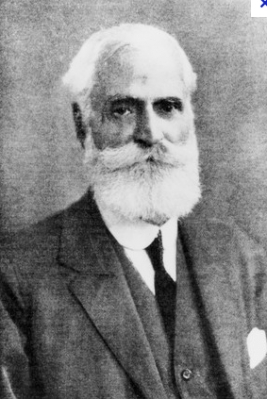St George William Lane Fox-Pitt was Pitt-Rivers' second child and second eldest son. He was born on 14 September 1856 in Malta whilst Pitt-Rivers was stationed there, and died on 6 April 1932. According to Bowden, he was independent, strong-willed, generous and rash. A businessman and inventor who held advanced political views detested by his father [Bowden, 1991: 33]
St George Fox-Pitt (until 1880 St George Lane Fox), Pitt-Rivers' second son, was a well-known pioneer in the development of electrical (incandescent) lights in the United Kingdom. He took out his first patent in 1874 at the age of eighteen for an electric cooking utensil. But by 1878 he had become interested in developing incandescent electric light.
He seems to have carried out most of his work, and submitted patents, between 1878 and 1883. Even before this though he had been interested in electricity, as quoted in the following site:
'...he had undoubtedly had a very remarkable youth, as three years earlier, in 1876, he had applied an electric ignition device of his own invention to the gas lamps of Pall Mall.'
See here for more information.
In Feburary 1881, when he was in his mid-twenties, he described his efforts to develop a working incandescent lamp in a letter to F.J. Smith:
"I had one lamp almost ready to seal off yesterday it had almost ceased giving off gas when I unluckily broke the Globe. Today I have another very promising one at work. The Char[r]ed Vulcanized Fibre is by far the best substance I have tried yet, it is strong & has a very high specific resistance." [quoted here]
As the above website makes clear, St George used a Mr Long of 12 Kirby Street, London, as a glass-blower, in the same letter as above he remarks that this is convenient as 'his shop is very near mine'
According to this site:
An independent panel analysed their results and concluded that Lane Fox's system was slightly less efficient than those of Edison or Swan. Nevertheless, he planned an electrical distribution system using parallel loads and earth return and he devised meters to measure the electricity used by consumers. Shortly thereafter he sold his patents to the Anglo-American Brush Electric Light Corporation, but by 1891, regained them to set up his own distribution company. However, it never became a major supplier.
It is not clear whether his interest in the invention and the application of new technologies was shared by his father, but it seems likely that it was. A phonograph, for example, was demonstrated at Rushmore in 1891 [Hawkins, 1982: 81-2, quoted in Bowden, 1991: 161] and Pitt-Rivers refers to Edison and his laboratory's inventions here.
St George Fox-Pitt was also interested in 'moral education' and psychical research. The latter at least was an interest he did share with his father, see here for a longer discussion of this. He wrote several books and pamphlets:
1913 / 1916 / 1924 / 1925 'The purpose of education: an examination of the education problem in the light of recent psychological research' Cambridge University Press
1920 'Free will and destiny'
He was an associate of King's College, University of London and Treasurer and Vice-President of the Moral Education League and the International Moral Education Congress.
Further Information
http://www.theiet.org/resources/library/archives/featured/lane-fox.cfm
http://de.wikipedia.org/wiki/St._George_Lane_Fox-Pitt
AP June 2012



